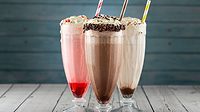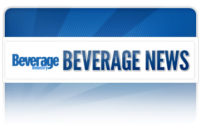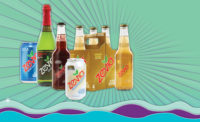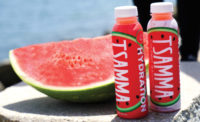In Fred Heatherton’s novelty song, “I’ve Got a Lovely Bunch of Coconuts,” the composer depicts a showman prodding people to play a game involving coconuts in order to make him rich. Although in the playful song coconuts are used to deceive consumers, today, coconuts — or more aptly coconut water — is more commonly perceived as a healthy complement for consumers.
“[Coconut water] is viewed as a healthy product,” says Jonas Feliciano, beverage analyst with Chicago-based Euromonitor International. “It’s viewed as a natural product, so consumers are flocking to it based on those benefits.”
Noting that Euromonitor tracks coconut water as part of the fruit and vegetable juice categories, Feliciano says that the top three brands — Vita Coco, New York; Zico, El Segundo, Calif.; and O.N.E. Coconut Water, Los Angeles — experienced 100 percent growth from 2011 to 2012 compared with a 3 percent decline for 100-percent juice during that same time period.
Coupled with that growing consumer interest, coconut water product launches have remained stable within the last two years, according to Innova Market Insights, Duiven, the Netherlands. Tracking the number of U.S. coconut water launches from January 2011 to November 2012, the market research firm reports that 60 coconut water products were launched in 2011 compared with 58 in 2012.
“The number of new product introductions in the last few years has been pretty consistent, so we’re not seeing huge growth and we’re not seeing a real decline in the number of products,” says Sarah Theodore, global drinks analyst for Mintel Food & Drink, Chicago.
Euromonitor’s Feliciano says the activity in product launches for coconut water began three years ago, and he has seen growth since that time period.
Feliciano notes that the coconut water segment is operating in the space where innovations around formats and flavors are taking shape. The segment also is benefiting from health and wellness trends and its functional positioning, he says.
“The positioning of coconut water as being a lower-calorie, natural alternative to a lot of sports drinks and the perception of it being a better way to hydrate than even water has really carried it in the market,” Feliciano explains.
At approximately 53 percent, natural was the top health positioning for U.S. coconut water launches from January 2011 to November 2012, according to Innova’s data. Other top health positions were allergy, gluten-free, sports and recovery, and no additives or preservatives, the market research firm reports.
Mintel’s Theodore notes that numerous industry trends have helped the sub-category’s success.
“This is a segment that has really benefited from a lot of current industry trends,” she says. “They all kind of converge on this category, and that includes all sorts of things: the shift to more natural products; the desire for products that are lower in sugar and calories; and also the popularity of sports and energy drinks.”
Theodore adds that for sports and energy drinks, the products don’t have to contain caffeine, but the natural electrolytes component speaks to hydration, which can be a more subtle way of delivering energy.
“If you’re more hydrated, you feel more energetic and that kind of thing, so all of those kinds of [trends] kind of converge on the coconut water category, and, I think, all have contributed to its gaining popularity in the last few years,” she says.
Difference makers
Although a number of industry trends are associated with coconut water’s awareness, in order for brand owners to differentiate themselves from the competition, flavors could play a vital role, experts note.
Last month, New York-based Vasinee Food Corp., the leading importer of Foco 100% Pure Coconut, introduced five tropical fruit flavors: Pineapple, Mango, Pomegranate, Pink Guava and Lychee. Like the Original variety, the five flavors will be packaged in 500-ml Tetra Pak cartons, contain five essential electrolytes and are low in calories, with 50 calories in each serving except for Mango, which contains 60 calories in each serving, the company says.
Vita Coco’s same-named brand also features a lineup of flavors. In 2011, the company partnered with R&B artist Rihanna to release its Tropical Fruit variety. The product combines coconut water with pink guava, orange, red dragon fruit and pineapple flavors and is packaged in a bright-magenta, aseptic carton featuring Rihanna’s signature to mark the collaboration.
Euromonitor’s Feliciano says that, similar to other emerging products, coconut water has somewhat risen out of the celebrity culture. He notes that as Hollywood embraced the idea of coconut water, consumers who idolize the celebrity-type culture and want to be a part of it could be consuming it even if they do not need the hydration benefit.
Within the category, fruit flavors are not the only option beverage-makers are implementing. Also in 2011, Zico released its same-named beverage in a Chocolate variety in 14-ounce, high-density polyethylene (HDPE) resealable bottles.
Mintel’s Theodore notes that the variety has remained unique to the category. “We don’t see chocolate a lot outside of dairy drinks or meal replacement shakes,” she says. “Those are probably the two most common areas that we see chocolate as a flavor, and most coconut waters have been blended with other fruit flavors so they have kind of a tropical image to [them], but chocolate is a really unique flavor.”
Noting the popularity of Chocolate as its top-selling flavor, Zico announced in 2012 that the variety now is available in a 1-liter package at key national retailers and amazon.com.
Although the market for pure coconut water has remained stable, hybrid drinks containing coconut water have seen an increase, Theodore notes.
“We’ve seen ready-to-drink coffees with coconut water in them, energy drinks and sports drinks, and drink introductions with coconut water and even some beverage mixes, some dry mixes and a liquid concentrate,” she says. “Coconut water’s been really versatile, and it’s being included in a lot of products that aren’t necessarily a straight coconut water.”
Arizona Beverage Co., Cincinnati, released last year CocoZona Espresso, which combines coconut water from Indonesian coconuts with espresso flavor and 50 mg of caffeine.
Santa Monica, Calif.-based Coco Café Co., in which Vita Coco is an investor, also offers its Café Latte that combines coconut water and espresso. Each serving contains 120 mg of caffeine, according to the company.
But coconut water brand owners aren’t the only ones exploring new formats with coconut water. RealBeanz, Brooklyn, N.Y., expanded its line of nutrient-enhanced, ready-to-drink coffees with the launch of Dark Roast Iced Coffee made with Coconut Water and Cappuccino Iced Coffee made with Coconut Water. Both varieties are made with 20 percent coconut water as well as premium-brewed beans and artificial growth-hormone-free milk.
Some sports drink brands also are highlighting the use of coconut water in their products and mentioning benefits such as potassium and electrolytes. For example, Seattle-based Golazo Inc. notes that its Golazo All Natural Sports Hydration drink line contains natural potassium from coconut water to promote muscle contraction and water absorption.
Coconut water hybrids also have found their way into alcohol products. Last year, MillerCoors, Chicago, launched Coco Brevé, a flavored malt beverage made with all-natural coconut water. Available in Kiwi Lime and Mango Citrus flavors, the drinks were available in limited quantities in Atlanta, Los Angeles, Miami, San Diego and Austin, Texas.
Coconut water’s versatility could play a vital role in its category growth, experts note.
“I think that’s been a really important key for the category in terms of introducing coconut water to the mainstream public,” Mintel’s Theodore says. “It’s been included in smoothies, in frozen desserts, energy drinks and sports drinks and all of that, and it’s made it really accessible to consumers and very easy for them to try it in a format that they’re already familiar with.
“I think, as a strategy, it’s been very successful because consumers can take a product that they already know, and they’re kind of familiar with that format already, and try coconut water that way and determine whether or not that’s a drink that they want to try then on its own,” she continues.
Euromonitor’s Feliciano says that the exposure for the different blends has been good overall for the category, but could pose problems later on.
“There could come a point when it could eventually turn bad in the sense that coconut water producers will want to differentiate themselves from some of these blends because some of the blends aren’t necessarily as healthy as 100 percent pure coconut water, so … while it’s good that it’s exposing more people to flavors, they want to make sure that people come back to the core product itself because a lot of these other blends are higher in sugars and things such as that,” he says.
Shelf appeal
As beverage-makers turn to different flavors and formats to differentiate their brand of coconut water from another, packaging also poses new opportunities, experts note.
“A lot of coconut water producers have chosen to go with eco-friendly cardboard packaging, which may also be driving the wellness category because a lot of wellness consumers are into eco-friendliness, so that may be one way to set themselves apart [is] the packaging,” says Agata Kaczanowska, beverage industry analyst with IBISWorld, Santa Monica, Calif.
For example, Taste Nirvana International Inc., Walnut, Calif., launched its Coco Motion brand in a 16-ounce can.
When coconut water first emerged on the scene, it was available mostly in aseptic packaging; however, an increasing number of brands are expanding into new packaging options, Mintel’s Theodore explains.
“They’ve been expanding into more bottles and cans and a lot of different sizes and materials both in glass and plastic, and that’s really helped make the drinks more mainstream,” she says. “We can expect to see more of that going forward and more brands using packaging to really stand out in the marketplace.”
Whether it's packaging, flavors or hybrids, the coconut water segment still has more opportunities to grow its consumer base.
“According to our consumer surveys, only about 10 percent of adults say they’ve personally used coconut water, so there’s still ample opportunity to expand the consumer base,” Theodore says. “Among the people who are currently using it, most of those consumers are younger; they’re under age 55, but they break out fairly evenly between men and women. So far, coconut water has really avoided being pigeon-holed as a drink for men or for women, and it’s managed to appeal to both.” BI










